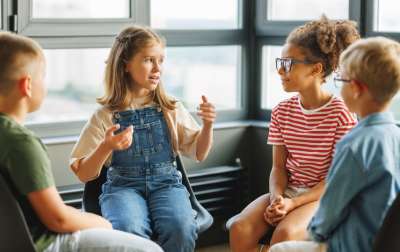Literature Circles
What Is It?
Whether they are called literature discussion groups, book clubs, reading response groups, or reading clubs, members of literature circles come together to discuss and respond to a book that they are reading at the same time. Often they are modeled after adult book discussion groups, although they may be more structured to provide scaffolding for students. In some models, roles are assigned to members of the group to help the group function more productively and remain focused on the chosen book or related topic. In literature circles, students use their experiences to create meaning, make connections, and have lively discussions about the book. The emphasis is on thoughtful dialogue in order to share experience and ultimately come to a deeper understanding of the piece of literature.
Why Is It Important?
In literature discussion groups, students hone their communication and critical-thinking skills by coming together with peers to respond to literature. Good readers use a variety of strategies to construct meaning from what they read, such as predicting what will happen next or connecting what they are reading to their own experience. Literature discussion groups help readers develop and practice these skills.
The overall objectives are for students to deepen their comprehension skills, construct meaning together as a group, debate and challenge each other, and ultimately connect with books on a deeper level. Students who are struggling readers often benefit by being in heterogeneous literature circles. Collaboration with more advanced peers provides modeling of comprehension strategies and critical thinking, as well as providing motivation for students to stretch their abilities in order to meet the group's expectations. Literature discussion groups can even have larger, more comprehensive benefits for the classroom community and for a student's lifelong learning. Harvey Daniels, in his book Literature Circles, discusses these types of benefits:
...literature circles have the potential to transform power relationships in the classroom, to make kids both more responsible for and more in control of their own education, to unleash lifelong readers, and to nurture a critical, personal stance toward ideas. (Daniels, p.31)
When Should It Be Used?
Many teachers wait to start book clubs or discussion groups until students have some shared experience with books. Some teachers wait until January or February, after students have built their skills of responding to books, talking about books, sharing their thoughts and reflections, and listening to each others' opinions with respect. Yet the work of building toward independent book discussions should start from the first days of school when you allow students ample opportunity to respond to literature in a variety of ways.
Initiating these literature discussion groups a bit later in the school year gives students time to build these skills, gives the teacher time to get to know students a bit better, and gives students time to get to know each other. A respectful and safe classroom community is essential. Literature circles, like all cooperative grouping strategies, depend on students who respect each other, listen to one another, and feel safe enough to share their thoughts and feelings.
What does it look like?
Literature circles generally range from three to six members who get together to choose and discuss a book. Some teachers choose to establish groups that are short-term and disband after the book is completed, while others form long-lasting groups, with members staying together to read and discuss many books.
Groups of students gather together in different areas of the classroom, perhaps in a comfortable corner on the floor, at a table, or simply in several chairs gathered together. Students discuss their books, with their books in hand or nearby, engaging every member of the group. Students use the books to refresh their memories, back up their observations or points, read a pertinent excerpt, or point out something they noticed to the group. Students also use the books to raise any questions they may have, while the group searches the text for possible answers.
Some literature circles have students take on different roles within the group, such as leading the discussion and keeping the group on track, identifying key passages and sharing them with the group, or finding connections between the text and the outside world. The teacher is on the periphery, helping to redirect the group's focus when necessary, or even as an occasional participant contributing thoughts or reactions about the book. The groups are not directed or lead by the teacher, as the primary voices are the students'.












